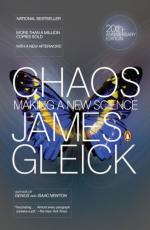
|
| Name: _________________________ | Period: ___________________ |
This test consists of 5 short answer questions, 10 short essay questions, and 1 (of 3) essay topics.
Short Answer Questions
1. Where was Robert May born?
2. What refers to the sensitive dependence on initial conditions; where a small change at one place in a nonlinear system can result in large differences to a later state?
3. In his paper, Kuhn argues that rival paradigms are ______, meaning that it is not possible to understand one paradigm through the conceptual framework and terminology of another rival paradigm.
4. When was Benoit Mandelbrot born?
5. When was James Yorke born?
Short Essay Questions
1. What led to Benoit Mandelbrot's epiphany in Chapter 4, "A Geometry of Nature"? Where was Benoit Mandelbrot working at the time?
2. How is James Yorke described in Chapter 3, "Life's Ups and Downs"? What term did he coin?
3. How did the role of chaos theory affect ecologists in the 1970s as described in Chapter 3, "Life's Ups and Downs"?
4. Who is quoted discussing nonlinear problems in Chapter 3, "Life's Ups and Downs"?
5. Describe the weather simulator discussed in Chapter 1, "The Butterfly Effect." What weather conditions did it create?
6. How is a Cantor set described in Chapter 4, "A Geometry of Nature"?
7. How did Lorenz develop ways to reproduce complex behavior in Chapter 1, "The Butterfly Effect"?
8. What was the early life of Benoit Mandelbrot like, as described by the author in Chapter 4, "A Geometry of Nature"?
9. What impact did The Structure of Scientific Revolutions have on the scientific community? What did Kuhn assert in the book?
10. How is Edward Lorenz described in Chapter 1, "The Butterfly Effect"? Where was he working at the time?
Essay Topics
Write an essay for ONE of the following topics:
Essay Topic 1
Describe Benoit Mandelbrot's work for International Business Machines Corporation. When was IBM founded and how was Mandelbrot involved in its evolution?
Essay Topic 2
Describe the life and work of Stephen Smale. What contributions is Smale responsible for in the study of chaos theory?
Essay Topic 3
Discuss the computer development of the 1960s and the Royal McBee computer used by Edward Lorenz. What did Lorenz develop to aid in computer analysis?
|
This section contains 885 words (approx. 3 pages at 300 words per page) |

|




